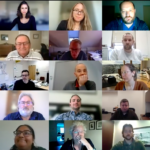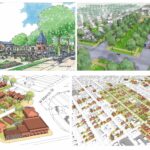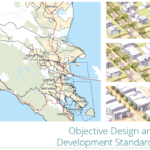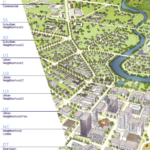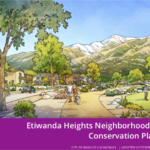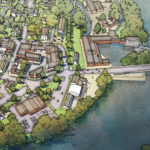FBCI Symposium Will Explore How Cities Can Be Redeveloped to Improve Public Health
Most of us know that a healthy lifestyle involves eating high-quality, nutritious food, getting regular exercise and plenty of rest, reducing stress and living in surroundings that lift the spirits. Unfortunately, typical American lifestyles often make it logistically — and in some cases, financially — difficult to maintain such a lifestyle.
Many of us spend much of our time driving long distances to and from work, and take additional trips to hit the grocery store or run other errands, work out or transport our kids to non-school activities or socialize. These constraints also compete with efforts to ensure that our activities, as well as the built and natural environments in which we conduct them, are improving rather than endangering our health. (How much healthier would we be if we could walk or cycle to most of our destinations, in air uncontaminated by carbon monoxide, for example?)
On Thursday, Feb. 16, FBCI will hold an educational symposium and fundraiser in San Francisco where a group of experts will discuss how urban communities can be transformed to improve residents’ health and quality of life. The symposium’s theme, “Urban Form as a Framework for Healthy Communities,” will feature a keynote presentation by Richard Jackson, M.D., a renowned expert on the nexus of urban form and public health.
In addition to being a well-known author and host of a 2012 public television series on the design of healthy communities, Jackson is professor and former chair of environmental health sciences at the Fielding School of Public Health at the University of California and former director of the Centers for Disease Control and Prevention’s National Center for Environmental Health. He was elected to the National Academy of Sciences’ Institute of Medicine and is an honorary member of the American Institute of Architects and the American Society of Landscape Architects.
Jackson believes that the ways in which many cities are laid out and developed contribute to sedentary lifestyles and isolation, triggering high rates of obesity, chronic disease, loneliness and depression. By way of healthier examples, he has singled out several success stories. He views Boulder, Colo., as the United States’ healthiest city, based on residents’ high exercise and low obesity rates, which he attributes to its 30-year history of providing bike routes that helped to instill a more healthy culture and lifestyle. He salutes Elgin, Ill., which, based on community input, rebuilt it dying downtown where the city’s main employer was closing its doors, into a revitalized, mixed-use destination. He also applauds West Oakland, Calif., which created a nonprofit cooperative to sell produce, and Syracuse, N.Y., for working to turn vacant lots into fruit and vegetable gardens. To be healthy, Jackson believes that cities must be diverse, inclusive and accessible.
“We built the U.S. around automobiles in the 20th century. It was wonderful when fuel and materials were extremely cheap, but it doesn’t meet the needs of the young, old, poor or disabled,” he said.
The symposium also will feature a presentation by architect and urbanist Dan Parolek, principal of OpticosDesign, Inc., in Berkeley, Calif., a leading firm in the field of form-based coding. Parolek is a founding board member of FBCI and co-authored the first comprehensive book on FBCs, “Form-Based Codes, a Guide for Planners, Urban Designers, Municipalities and Developers.”
Parolek’s firm created the Missing Middle Housing concept, which encourages the development of a range of multi-unit or clustered housing types that are compatible in scale with and can be built alongside single-family homes, such as duplexes, fourplexes and bungalows surrounding a shared courtyard, which can accommodate households of various sizes and incomes, and can be built near neighborhood retail shops and public transit.
This type of housing will meet the needs of young families who cannot afford new single-family homes, older adults who want to downsize and have access to amenities nearby, and lower- and middle-income Americans for whom high-priced rental apartments and new housing is out of reach. Parolek pointed out that this type of housing is routinely built in Europe and was once common in various U.S. cities. Re-establishing this type of housing can give Americans more choices of where to live, encourage more social interaction between neighborhood residents while increasing the housing supply, thus slowing the rise of rental prices.
The presentations will be followed by a response panel of experts with varying perspectives on the topic. The featured panelists are:
- Lisa Wise (moderator) is chair of FBCI and president of Lisa Wise Consulting in San Obispo, Calif. She is a certified public accountant and planner with almost 25 years of professional experience in land-use planning, housing policy, development codes and finance. Wise speaks regularly at state and national conferences and is an expert on comprehensive planning solutions, the economics of land-use planning, and zoning ordinances and development codes.She also teaches at California Polytechnic State University as adjunct faculty in the College of Architecture and Environmental Design.
- Elizabeth Baca, M.D., is senior health advisor in the California Governor’s Office of Planning and Research. She is engaged in public sector innovation to foster health through many projects, including healthy planning, big data and public-private partnerships. Baca also is involved in the U.S. Green Buildings Council, which works with government, member businesses and allied organizations to support policies and programs that advance greener buildings and communities. While a member of the general pediatric faculty at Stanford Medical School, she was the lead faculty mentor on projects designed to increase access to healthy foods, reduce environmental asthma triggers, increase physical activity opportunities and improve the built environment.
- Kathryn Boyle is the community manager of Kaiser Permanente’s Community Health Benefits Program, where she works on place-based funding initiatives to improve public health. For example, she manages the Healthy Eating Active Living (HEAL) portfolio of strategic, responsive and technical assistance grants that foster healthy behaviors, through environmental and policy change. HEAL is designed to create a sphere of influence that makes it easier for community members to eat healthier foods and be more physically active throughout life. The program empowers communities to make healthy changes, such as adding salad bars in schools and improving school lunches, offering breastfeeding and healthier living counseling and classes in community clinics and providing leadership development to community residents in specific neighborhoods.
- Erik Calloway is senior planner at ChangeLab Solutions in Oakland, Calif., which provides community-based solutions for America’s most common and preventable diseases, such as cancer, heart disease, diabetes, obesity and asthma. He conducts research, prepares strategies and develops tools to help communities support healthy living and sustainability. As an urban design consultant, he led multidisciplinary teams on streetscape and public space design, district and corridor restructuring, city planning, neighborhood development and downtown revitalization projects.
FBCI’s symposium and fundraiser will be held at the McLoughlin Gallery in San Francisco from 6:00 p.m. to 8:00 p.m. and will include a networking reception. To learn more about this event and register, visit the Symposium page.


